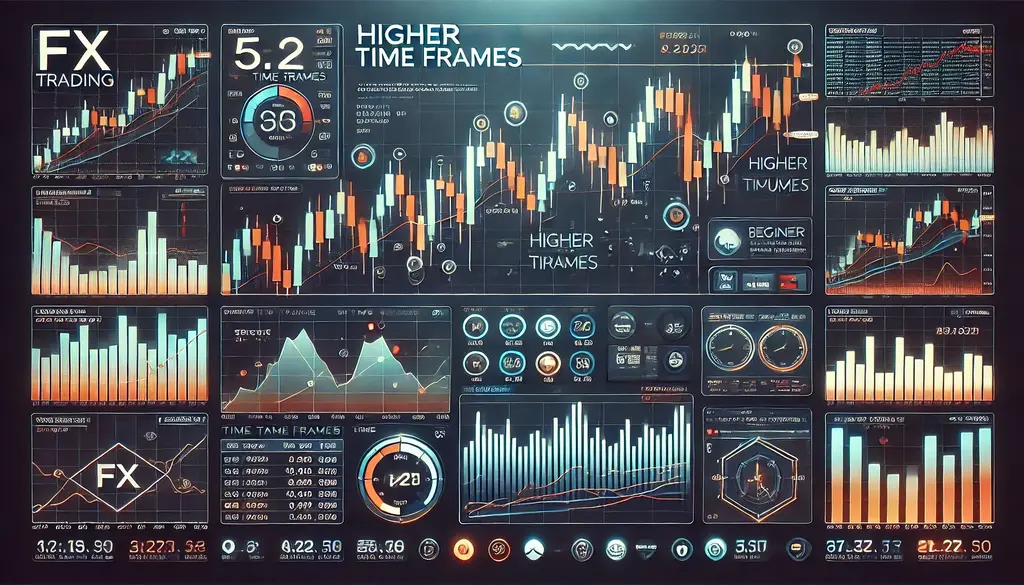In FX trading, the concepts of higher timeframes and lower timeframes are very important. By utilizing higher timeframes, you can grasp market trends from a longer-term perspective, and by using lower timeframes, you can find specific entry opportunities. In this blog, we will explain in detail how to utilize higher and lower timeframes, which are essential for FX traders.
- 1 Understanding Higher Timeframe Charts
- 1.0.1 Characteristics and Role of Higher Timeframe Charts
- 1.0.2 Characteristics and Role of Lower Timeframes
- 1.0.3 Points for Utilizing Lower Timeframes
- 1.0.4 Interaction Between Higher Timeframe and Lower Timeframe
- 1.0.5 Summary
- 1.0.6 What is the Significance of Higher Timeframe Charts?
- 1.0.7 How to Identify Trends
- 1.0.8 Making the Most of Indicators
- 1.0.9 How to Read Trends for Practical Application
- 2 Identifying Trading Opportunities with Lower Timeframes
- 2.0.1 Spotting Trend Reversals
- 2.0.2 Utilize Technical Indicators
- 2.0.3 Confirming Support and Resistance
- 2.0.4 The Importance of Waiting
- 2.0.5 Prioritize the Trend of Higher Timeframes
- 2.0.6 Be Aware of Timeframe Combinations
- 2.0.7 Utilize Support and Resistance
- 2.0.8 Determining Entry Timing
- 2.0.9 Prioritizing Mental Stability
- 2.1 Summary
- 2.2 Frequently Asked Questions
- 2.3 Reference Sites
Definition of Higher Timeframe
A higher timeframe refers to a candlestick formed on a longer time axis than the current timeframe being referenced by a trader. For example, if trading with 1-minute charts, 5-minute, 15-minute, daily, or weekly charts would be considered higher timeframes. These higher timeframes are key for understanding overall market trends.
The Importance of Higher Timeframes
Higher timeframes are essential for accurately understanding market trends and flow. Short-term price fluctuations often contain a lot of noise, and looking only at lower timeframes can lead to misinterpreting the actual market movements. By understanding higher timeframes, you can grasp the direction of trends, avoid unnecessary contrarian positions, and increase your trading success rate.
How to Use Higher Timeframe Charts
To effectively apply higher timeframe charts to trading, it is important to first clearly recognize the trend. If the higher timeframe chart shows an upward trend, it would be wise to consider a buy entry on the lower timeframe charts. Conversely, in a downward trend, you should consider a sell entry. By combining higher timeframe and lower timeframe charts, trades with a higher probability of success can be achieved.
Key Points for Analyzing Higher Timeframes
When analyzing higher timeframes, it’s important to be aware of the direction of the trend as well as the location of support and resistance lines. This allows you to predict where prices may bounce or break through. Understanding support and resistance in higher timeframes helps build effective trading strategies.
As mentioned above, correctly understanding and identifying higher timeframes is an important factor for FX traders to grasp the overall market situation and aim for a high win rate. Higher timeframes are the foundation of FX trading, and deepening your understanding can lead to more effective trades.

Understanding Higher Timeframe Charts
Characteristics and Role of Higher Timeframe Charts
Higher timeframe charts refer to candlesticks formed over a longer period than the candlestick currently being focused on. For example, if you are looking at a 15-minute chart, higher timeframe charts would be 30-minute, hourly, or 4-hour charts. Approaching from this long-term perspective allows you to understand the overall flow of trends.
The main benefits of using higher timeframe charts include:
- Trend Identification: By analyzing higher timeframe charts, you can determine whether the current trend is rising or falling and grasp the long-term direction.
- Price Level Identification: You can identify important price ranges such as support and resistance formed on higher timeframe charts, which greatly aids in decision-making when entering or retrading.
Characteristics and Role of Lower Timeframes
In contrast, lower timeframes show candlesticks with a shorter timeframe than the candlesticks we are currently observing. For example, when looking at a 15-minute chart, a 5-minute or 1-minute chart would be considered a lower timeframe. By paying attention to lower timeframes, it is possible to quickly respond to short-term market trends and avoid missing entry and exit opportunities.
Points for Utilizing Lower Timeframes
- Detecting Entry Timing: Understanding short-term price movements helps to identify optimal entry points.
- Strengthening Risk Management: Being sensitive to short-term price movements makes it effective for determining stop-loss and take-profit timings.
Interaction Between Higher Timeframe and Lower Timeframe
Higher timeframes and lower timeframes appear to be conflicting entities, but in reality, they have a complementary relationship. By understanding the direction of trends through higher timeframes and using lower timeframes for entry and exit points, you can achieve a higher success rate. For example, if the higher timeframe indicates an uptrend, confirming an entry signal on the lower timeframe can lead to a high-expectation trading opportunity. On the other hand, when the higher timeframe shows a downtrend, caution is needed for upward signals on the lower timeframe.
Summary
Higher timeframes and lower timeframes have different roles in FX trading, but are closely related in trading. Analyzing the higher timeframe to confirm the overall trend and using that information to utilize the lower timeframe to construct specific trading strategies will lead to success in trading. Through this understanding, you should be able to improve the quality of your trades.
What is the Significance of Higher Timeframe Charts?
Higher timeframe charts, in trading, refer to candlestick charts used to understand market trends from a longer-term perspective. Specifically, charts with a certain time frame, such as daily or weekly charts, are utilized. By referencing these higher timeframe charts, traders can understand the overall market trend and effectively evaluate the impact of short-term price fluctuations.
How to Identify Trends
When reading trends using higher timeframe charts, it is important to focus on the following points.
Trend Analysis
By checking the higher timeframe chart, you can determine whether the price is rising or falling. For example, in an uptrend, a characteristic feature is that highs and lows gradually rise, while in a downtrend it is the opposite. It is important to base your trading strategy on this.Confirmation of Support and Resistance
Based on past price data, it is possible to identify support lines and resistance lines on the higher timeframe chart. These lines are touchstones that indicate points where prices may bounce back or trends may reverse. It is particularly important to observe whether new highs or lows are being formed along the trend.
Making the Most of Indicators
Oscillators and moving averages, among other indicators, are extremely useful for capturing signs of trend strength or reversals. Using them allows you to grasp the continuity and turning points of trends even more clearly.
Using Moving Averages
There is a method of combining short and long moving averages and using the timing of their intersection as entry or exit signals. In particular, when the short line crosses above the long line, it is considered a buy signal, and conversely, when it crosses below, it is regarded as a sell signal.Utilizing Oscillators
Using indicators such as the RSI (Relative Strength Index) and MACD (Moving Average Convergence Divergence) helps you determine whether the market is in an overbought or oversold state, assisting in finding potential trend reversals. This allows you to find more specific entry points.
How to Read Trends for Practical Application
To effectively utilize higher timeframe charts, please refer to the following steps.
Check Higher Timeframe Charts
First, look at daily or weekly charts to understand the overall direction of the market.Identify Price Trends and Support/Resistance
Find important support lines and resistance lines on the higher timeframe, and consider where prices may bounce.Set Trading Strategy Based on Trend
By understanding the direction of the trend, determine how to take positions and manage funds accordingly, which can lead to more effective trading.
Always be aware of the movements of higher timeframe charts and grasp the overall market trend, which is essential for success in FX trading.

Identifying Trading Opportunities with Lower Timeframes
Spotting Trend Reversals
The first step in entering trades based on lower timeframes is to identify trend reversals. While keeping the direction of the higher timeframe trend in mind, observe the lower timeframe chart. Specifically, pay attention to patterns such as:
- M Top or Head and Shoulders: These are patterns often seen when trends reverse. If these patterns form on the lower timeframe while you’ve confirmed a downtrend on the higher timeframe, it can be an entry opportunity.
- Pin Bar: A pin bar is one sign of price reversal. Pin bars forming at support or resistance levels suggest a strong potential for bounce.
Utilize Technical Indicators
Using indicators allows you to better visually understand market conditions. The following indicators are particularly effective:
- Moving Average: Points where the short-term moving average crosses the higher timeframe trend can be used as an entry filter. When the higher timeframe is declining, crossing from above to below with the short-term moving average indicates a potential entry point.
- MACD: The MACD histogram and signal line crossovers also serve as references for not missing entry opportunities. In particular, when the MACD crosses the zero line, it can be a new entry signal that aligns with the higher timeframe trend.
Confirming Support and Resistance
Support lines and resistance lines are also effective tools for finding lower time frame entry opportunities. Use them as follows:
- Confirming Rebounds: When approaching support or resistance levels, there’s a high probability of a rebound, making it worthwhile to consider an entry. If the higher time frame shows a trend, you can target rebounds on the lower time frame.
- Utilizing Breakouts: When price breaks through support or resistance, a transition to the next trend is expected. Entering based on this breakout allows you to ride the wave of an upward or downward trend.
The Importance of Waiting
Rushing into entries increases the risk of retracements. Remember the importance of waiting for entry opportunities. For example, if the day’s market flow doesn’t feel healthy, it’s also important to decide to skip the next entry. By waiting patiently until a favorable signal is confirmed, you can increase your trading success rate.
Use these techniques to avoid missing entry opportunities on lower timeframes and achieve high-probability trades.
Prioritize the Trend of Higher Timeframes
When starting a trade, it is essential to first confirm the trend of higher timeframes. If the higher timeframe is an uptrend, looking for buy signals on lower timeframes can be effective. Conversely, when the higher timeframe is a downtrend, you need to be aware of sell signals on lower timeframes. Entering trades that follow the trend of higher timeframes will help increase the probability of success.
Be Aware of Timeframe Combinations
It’s also crucial to effectively combine the timeframes of higher and lower timeframes. For example, using daily or weekly charts as higher timeframes and 1-hour or 15-minute charts as lower timeframes allows you to understand the overall market trend while finding specific entry points. Also, following trends in multiple higher timeframes increases trading stability.
Utilize Support and Resistance
Support lines and resistance lines visible on higher timeframes can be effectively utilized in combination with lower timeframe chart analysis. Near support lines on the higher timeframe, you can expect a high probability of entry by looking for reversal signals on the lower timeframe. Also, upward signals on the lower timeframe approaching resistance lines on the higher timeframe involve risk and require caution.
Determining Entry Timing
It is also important to determine the timing of your entry. Pay attention to moments when higher timeframe trends change or trendlines are broken, and combine those signals with lower timeframe indicators for more favorable trades.
Prioritizing Mental Stability
In trading, mental factors have a significant impact. By focusing on the higher timeframe chart conditions while trading, you can make calm judgments. Continuing to trade with awareness of the higher timeframe flow, without being influenced by temporary lower timeframe movements, leads to mental stability and is key to successful trading.
Summary
In FX trading, understanding and appropriately utilizing the concepts of higher timeframes and lower timeframes is extremely important. Grasping the overall market trend through higher timeframes and subsequently identifying entry opportunities on lower timeframes without missing them is essential for stable trading. Furthermore, by balancing both and combining various factors such as confirming support and resistance and determining appropriate timing, trades with a higher probability of success become possible. In this way, skillfully practicing the distinction between higher and lower timeframes can be said to be a shortcut to success for FX traders.
Frequently Asked Questions
What are Higher Timeframe Charts?
Higher timeframe charts refer to candlesticks formed on a longer time axis than the current chart being referenced by a trader. For example, if you’re trading with 1-minute charts, 5-minute, 15-minute, daily, or weekly charts would be considered higher timeframe charts. Higher timeframe charts are key to understanding overall market trends.
How Should You Use Higher and Lower Timeframe Charts?
You can achieve a higher success rate by understanding the direction of trends through higher timeframe charts and using lower timeframe charts to determine entry and exit timing. It is effective to look for entry opportunities on lower timeframes in line with the trend of the higher timeframe chart.
What Techniques are There for Finding Entry Opportunities on Lower Timeframe Charts?
Identifying trend reversals, utilizing technical indicators, and confirming support and resistance are key points for finding entry opportunities on lower timeframe charts. It is also important to wait patiently until a favorable signal is confirmed.
What are the Tips for Differentiating Between Higher and Lower Timeframe Charts?
Prioritizing higher timeframe trends, being aware of time axis combinations, utilizing support and resistance, determining entry timing, and emphasizing mental stability are the tips for differentiating between higher and lower timeframe charts.
Reference Sites
FX取引で、初心者なので新規注文を出すタイミングがわからなくて悩んでいるという人はいませんか?FXで新規注文のタイミング…











